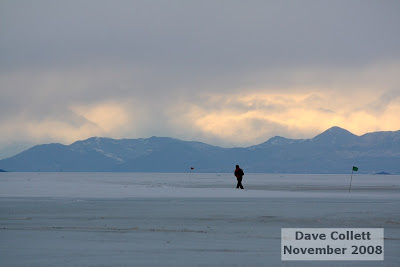We set up our GPS out on the sea-ice in front of Scott Base yesterday (which involved digging a 1x3x2m hole in the snow first to get to the ice). So we're hoping that it hasn't been blown away. We would go out to check, but the weathers too bad. We're getting glimpses of it through the spindrift, so we know its still there.. We guyed it down, and it's kinda sheltered by the hole, so fingers crossed. I also splashed some water round the legs to help freeze it in. Will try and get some photos next time we go out- there was a lot of spindrift when we were setting it up, so not good for photos.
Anyway, this post is about a couple of days (Wednesday and Thursday) which we spent at Cape Evans.This was the base for Captain Robert Falcon Scott's expedition to the South Pole, from which he never returned. (His ship was called the Terra Nova, for the record). The Antarctic Heritage Trust conservators (see a previous post) have just moved to this hut, after completing work at Shackletons hut at Cape Royds. They're working out of converted shipping containers which are currently sitting on the sea-ice. They camp on the land a couple of hundred metres away (apparently the polar tents are warmer).
So we were doing similar work at Evans as we were doing at Royds- surveying the hut for vertical movement. We also did some other work for the AHT- surveying some features around the site which can be used for the relative positioning of artifacts that will be discovered in the ice surrounding the hut. A recent problem at Cape Evans has been the buildup of ice and snow around the southern side of the hut. A few years ago you were able to step directly from the snow onto the roof, and there's still over 1.5m of solid ice in places! To counter this 5 'vortex generators' were installed last week to try and stop the wind from depositing snow around the hut. They're also putting gravel (scoria) on top of the ice so that the sun melts it. Anyway, we did some cross-sections so that the level of melting will be able to be quantified.
It was great to spend a night there- talking to the conservators about their work and just being away from base was good. Glen and I slept in a wannigan (a little hut on a sled), which was ok, except for the wind which we were sure was going to push us all the way across McMurdo Sound!
I found Scott's hut to have a completely different feel to Shackleton's. At Shackleton's you walked into this big open space, and there was a lot of light streaming in. Scott's on the other hand, felt dark and cold, and everything was broken up into cubicles a lot more. Scott's hut was also used by Shackleton's marooned Ross Sea Party, and they burnt a lot of seal blubber in the hut, so the soot from that darkened the place, but it definitely had a different feel. Shackleton's was welcoming, whereas at Scott's you felt like you shouldn't be there..
Anyway, onto the photos:

Uncovering a dog skeleton which has been covered up to help preserve it.

Jana, one of the conservators walking back to their camp.

Looking across McMurdo Sound.

Geared up for some Antarctic surveying. Note the head-torch!

Here's why I needed the torch- so that we could see the tape in the dark stables.



















No comments:
Post a Comment